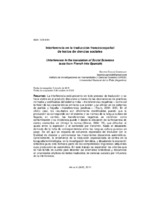Mostrar el registro sencillo del ítem
Interferencia en la traducción francés/español de textos de ciencias sociales
| dc.contributor.author | Emilce Cagnolati, Beatriz | |
| dc.date.accessioned | 2020-01-29T10:42:07Z | |
| dc.date.available | 2020-01-29T10:42:07Z | |
| dc.date.issued | 2015 | |
| dc.identifier.issn | 1579-9794 | |
| dc.identifier.uri | http://hdl.handle.net/10396/19403 | |
| dc.description.abstract | La interferencia está presente en todo proceso de traducción y se hace visible en el producto discursivo a través de las desviaciones de prácticas normales y codificadas del sistema meta —transferencias negativas— como así también de las características similares que existen y se utilizan en los sistemas de partida y llegada —transferencias positivas— (Toury, 2004: 345). En el último caso, los resultados son difícilmente identificables puesto que la producción se corresponde con el sistema y las normas de la lengua-cultura de llegada; en cambio, las transferencias negativas se visibilizan como contaminación y su incidencia puede ir desde la elevación de la frecuencia de ciertos elementos sin infringir la norma (Sinner, 2004: 73), que dificultan el ajuste entre la expresión y el contenido por transmitir, hasta el desacierto derivado de la falta de correspondencia entre las lenguas-cultura puestas en juego. De allí que se requiera de esfuerzos especiales del traductor con la finalidad de disociar y contrarrestar los mecanismos discursivos automáticos. Generalmente, la enseñanza de la traducción especializada se centra en la búsqueda terminológica, en la investigación temática, y desatiende la expresión sintáctica pues esta formaría parte de las competencias lingüísticas adquiridas cuya producción es automática. En este trabajo se expondrán los criterios que se han tenido en cuenta para describir las anomalías sintácticas y discursivas en enunciados elípticos de textos traducidos de ciencias sociales por influencia de la interferencia. | es_ES |
| dc.description.abstract | Interference is present in every translation process and becomes visible in the discourse product through deviations from the normal and codified practices of the target system –negative transferences– as well as in the similar features that exist and are used in both source and target systems –positive transferences (Toury, 200: 345). In the latter case, the results are hardly identifiable because the production corresponds to the system and the norms of the target language-culture; on the other hand, negative transferences become visible as a contamination and their incidence can go from the growth in the frequency of certain elements without breaking the norm (Sinner, 2004: 73) – which complicates the adjustment between the expression and the content to be transmitted–, to the mistake derived from the lack of correspondence between the languages-cultures at stake. This is why special efforts are required from the translator in order to dissociate and counteract automatic discourse mechanisms. Usually, the teaching of specialized translation focuses on terminological search, on thematic research, and neglects syntactic expression, for this would be part of the acquired linguistic competences, whose production is automatic. In this paper, we shall enumerate the criteria which have been taken into account in order to describe the syntactic and discourse anomalies in elliptic statements from translated Social Sciences texts by the influence of interference. | es_ES |
| dc.format.mimetype | application/pdf | es_ES |
| dc.language.iso | spa | es_ES |
| dc.publisher | UCOPress | es_ES |
| dc.rights | https://creativecommons.org/licenses/by-nc-nd/4.0/ | es_ES |
| dc.source | Hikma 14, 55-74 (2015) | es_ES |
| dc.subject | Interferencia | es_ES |
| dc.subject | Traducción | es_ES |
| dc.subject | Producción discursiva | es_ES |
| dc.subject | Enunciados elípticos | es_ES |
| dc.subject | Anomalía sintáctica | es_ES |
| dc.subject | Anomalía discursiva | es_ES |
| dc.subject | Binomio textual | es_ES |
| dc.subject | Interference | es_ES |
| dc.subject | Translation | es_ES |
| dc.subject | Discourse production | es_ES |
| dc.subject | Elliptic statements | es_ES |
| dc.subject | Syntactic anomaly | es_ES |
| dc.subject | Discourse anomaly | es_ES |
| dc.subject | Textual pairing | es_ES |
| dc.title | Interferencia en la traducción francés/español de textos de ciencias sociales | es_ES |
| dc.title.alternative | Interference in the translation of Social Sciences texts from French into Spanish | es_ES |
| dc.type | info:eu-repo/semantics/article | es_ES |
| dc.relation.publisherversion | https://www.uco.es/ucopress/ojs/index.php/hikma/index | es_ES |
| dc.rights.accessRights | info:eu-repo/semantics/openAccess | es_ES |

